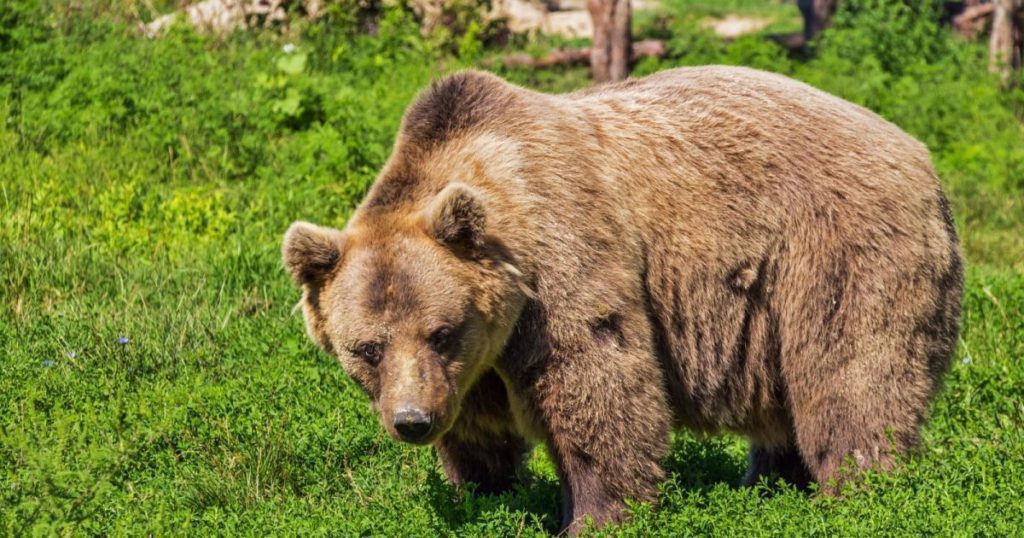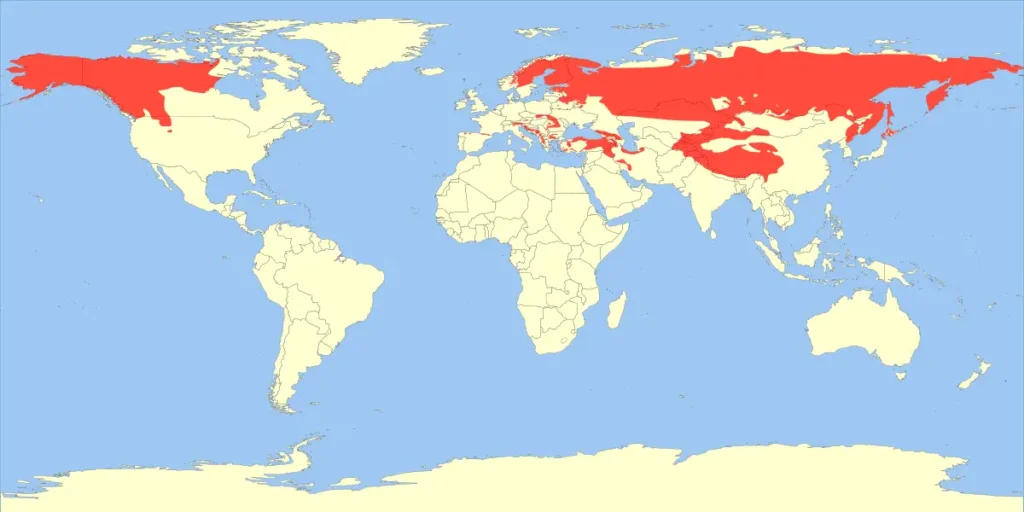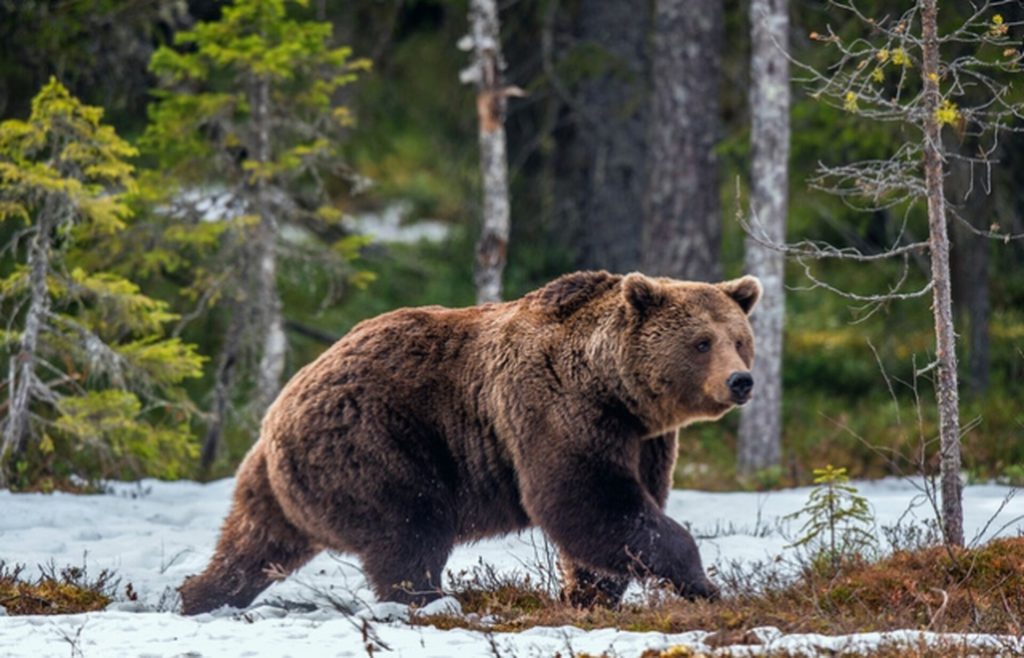Brown Bear (Ursus arctos)- one of the most famous and widespread bear species on the planet. This mighty predator is a symbol of strength, endurance and wildlife. It can be found in the dense forests of Europe, mountainous regions of Asia, and even in the harsh conditions of Alaska and Siberia.
Thanks to its intelligence, excellent adaptive abilities, and omnivorous lifestyle, the brown bear plays a key role in many ecosystems. In this article, we will look at all aspects of the life of this unique species: its biological features, food habits, social behavior, threats and protection measures.

1. General characteristics of the brown bear
🔬 Scientific classification:
✔ The Kingdom: Animals (Animalia)
✔ Type: Chordal (Chordata)
✔ Class: Mammals (Mammalia)
✔ Row: Predatory animals (Carnivora)
✔ Family: Bearish (Ursidae)
✔ Gender: Bears (Ursus)
✔ View: Brown Bear (Ursus arctos)
📍 Habitat range:
✔ Europe (Carpathians, Alps, Scandinavia, Pyrenees)
✔ Asia (Siberia, Caucasus, Himalayas)
✔ North America (Alaska, Canada)
📏 Sizes:
✔ Males: 1.5-3 m in length, weight-180-600 kg
✔ Females: 1.5-2.5 m in length, weight-100-350 kg
📌 Interesting!
The largest recorded brown bear weighed 1134 kg and had a height of 3.39 m standing on your hind legs!
🏃 Speed:
✔ Running-up 50 km / h
✔ Swimming – up to 6 km / h
🌡 Temperature range:
✔ Lives in regions with temperatures from -50°C to +30°C
2. subspecies of the brown bear
There are several subspecies of the brown bear, each of which has its own characteristics:
🔹 Grizzly bear (Ursus arctos horribilis) - it is native to North America and has a more aggressive nature.
🔹 Kamchatka bear (Ursus arctos beringianus) - one of the largest subspecies, lives in Russia.
🔹 Tibetan bear (Ursus arctos pruinosus) - a rare subspecies adapted to life in the highlands.
🔹 European brown bear (Ursus arctos arctos) - lives in the Carpathians, Alps, and Scandinavia.
🔹 Himalayan brown bear (Ursus arctos isabellinus) - it lives in the Himalayas, has light brown fur.
3. Appearance and anatomy
🔹 Wool:
✔ Light brown to dark brown color
✔ Thick and long, especially at the withers
✔ It gets thicker and thicker in winter
🔹 Paws:
✔ Powerful with large claws (up to 12 cm)
✔ Uses its front paws for digging, hunting, and climbing trees

🔹 Teeth and jaws:
✔ 42 teeth adapted to different diets
✔ Powerful jaws can easily break bones
📌 Interesting!
Brown bears can stand on their hind legs to get a better view of the area.
4. lifestyle and behavior
🏡 Territory:
✔ Males have huge territories-up to 5000 km2
✔ Females occupy smaller territories-up to 1000 km2
🛶 Migrations:
Bears travel in search of food, especially in the fall before wintering.
🌙 Daily activity:
✔ Mostly lead a solitary lifestyle
✔ Active during the day in summer, mostly at night in autumn

5. eating habits and hunting behavior
🍽 Basic diet:
✔ Plants-berries, roots, nuts
✔ Animal food-fish, insects, small mammals
✔ Carrion-willingly eats the remains of dead animals
🔪 Hunting methods:
✔ Catches fish in rivers
✔ Can attack ungulates
📌 Interesting!
A brown bear can eat up to 40 kg of food per day before wintering!

6. reproduction and life cycle
💑 Mating season:
✔ May-July
✔ Males often fight for females
🐣 Pregnancy and birth:
✔ Pregnancy – 6-8 months
✔ 1-3 cubs are born in a winter den
🐻 Mother and cubs:
✔ Cubs stay with their mother 2-3 years old
Their mother teaches them to search for food and survive
📌 Interesting!
Newborn cubs weigh only 500 g!
7. hibernation
❄ How do bears spend the winter?
✔ Spend the winter in dens made of leaves and branches
✔ Disable most life processes
✔ Do not eat or drink during hibernation
📌 Interesting!
Body temperature of a bear during hibernation does not fall below 31°C, which allows you to quickly wake up in case of danger.
8. threats and protection of the species
⚠ Main threats:
✔ Deforestation
✔ Hunting and poaching
✔ Climate change
⚖ Security measures:
✔ Listed in the Red Book
✔ Protected in national parks
📌 Interesting!
In Ukraine, the brown bear has been preserved in the Carpathians, its number – about 300 individuals.
Conclusion
The brown bear is one of the most powerful and intelligent predators on our planet. It is perfectly adapted to life in various conditions, and its ecological role is irreplaceable. However, due to human impact, its population is declining, and conservation measures are needed to preserve the species.
The brown bear is not only a symbol of wildlife, but also a reminder of the importance of preserving ecosystems for future generations.